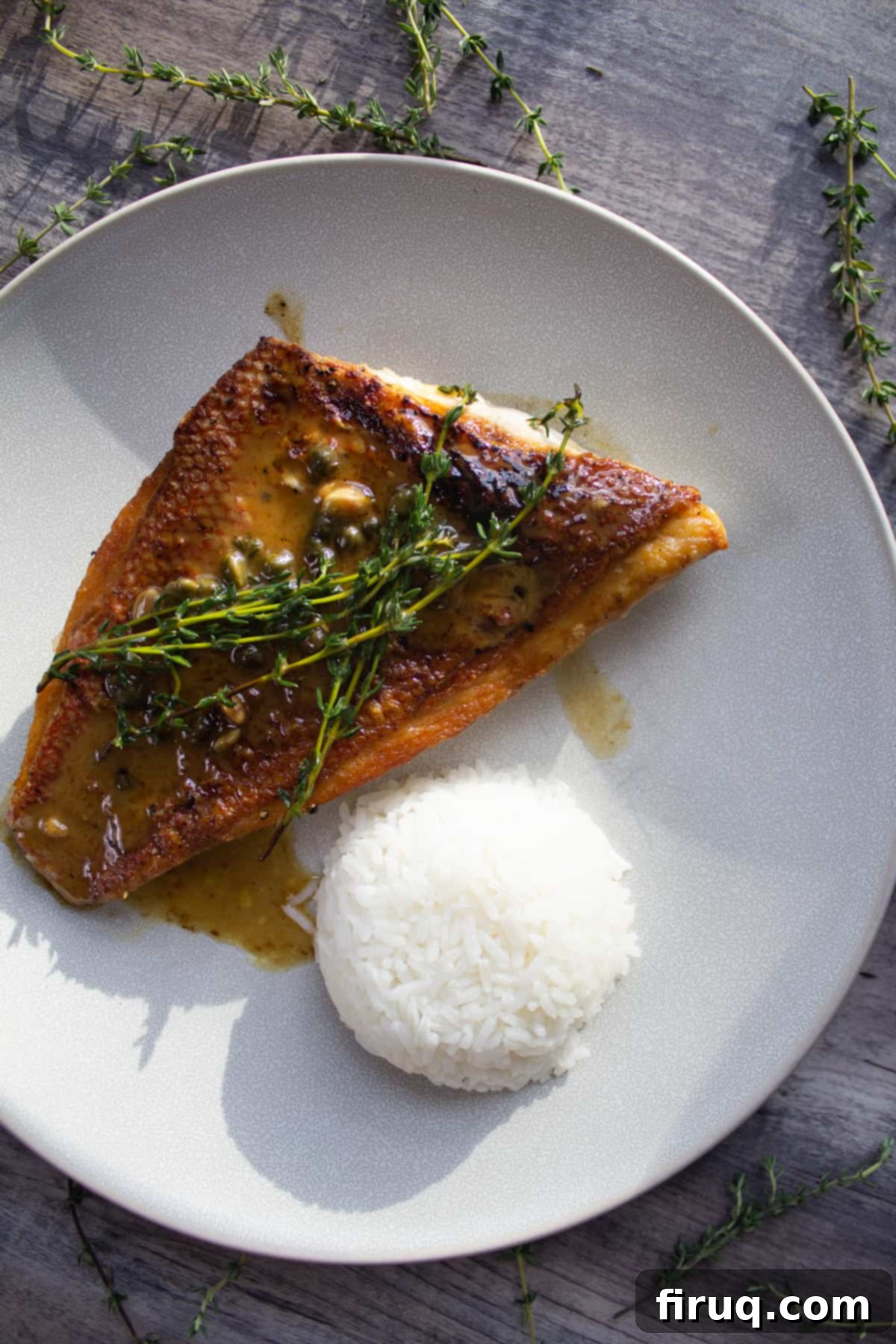Crispy Pan-Seared Vermillion Snapper with Lemon-Caper Thyme Sauce: An Irresistible Seafood Delight
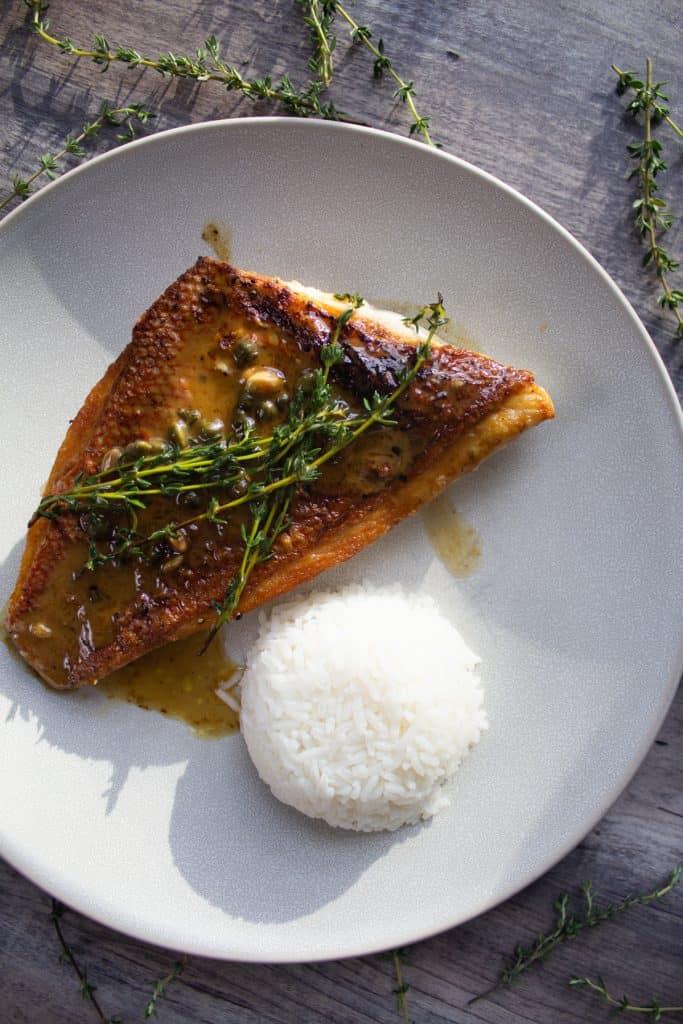
Embark on a culinary adventure with the exquisite flavors of fresh fish, starting with this incredible pan-seared vermillion snapper recipe. Whether you’re a seasoned seafood lover or just beginning to explore the world of oceanic delights, vermillion snapper is an excellent choice. Known for its mild, sweet flavor and firm, flaky texture, it’s often described as one of the least “fishy” tasting options, making it perfect for those who prefer a subtler seafood experience. This dish isn’t just a meal; it’s an introduction to simple, elegant cooking that brings out the best in fresh ingredients.
For us, fresh seafood is a weekly ritual. Living in North Carolina, we’re fortunate to have access to vibrant farmer’s markets, where we consistently find the freshest catches. Every Saturday, our home transforms into a seafood haven. While many families observe a “fish on Friday” tradition, our schedule dictates Saturdays for our market runs, ensuring we get the prime selection for our weekend feast. This routine allows us to connect with local purveyors and truly appreciate the journey of our food from the ocean to our plate.
Our vermillion snapper, much like the flounder featured in our popular Lemon Garlic Broiled Flounder recipe, often comes from Locals Seafood. This fantastic North Carolina-based company is renowned for its commitment to fresh, high-quality fish and their deep knowledge of the products they sell. Supporting local businesses like Locals Seafood not only guarantees superior ingredients but also allows us to learn more about sustainable fishing practices and the diverse species available in our region.
Vermillion Snapper vs. Red Snapper: Understanding the Differences
When discussing snapper, the vermillion variety is often compared to its more famous cousin, the red snapper. Both share a similar delicate taste profile and a visually striking red hue, which can make them seem interchangeable at first glance. However, there are distinct differences that set them apart, especially for those keen on specific culinary outcomes.
Red snapper typically grows much larger, yielding thicker, more substantial fillets. Vermillion snappers, on the other hand, are generally smaller and more streamlined. They’ve earned the nickname “beeliners” due to their impressive speed and agility in the water, a stark contrast to the slightly slower, more powerful red snapper. These differences in physique hint at their contrasting hunting behaviors: vermillion snappers are active pursuers of their prey, while red snappers tend to be ambush predators, waiting for the opportune moment. You can delve deeper into their unique hunting styles here.
Despite these distinctions, both types of snapper are incredibly versatile and can be prepared using similar cooking methods. For this recipe, pan-searing is our chosen technique, as it perfectly complements the firm flesh of both vermillion and red snapper, creating a delightful crispy exterior and a tender, juicy interior.
Mastering the Art of Pan-Searing Snapper
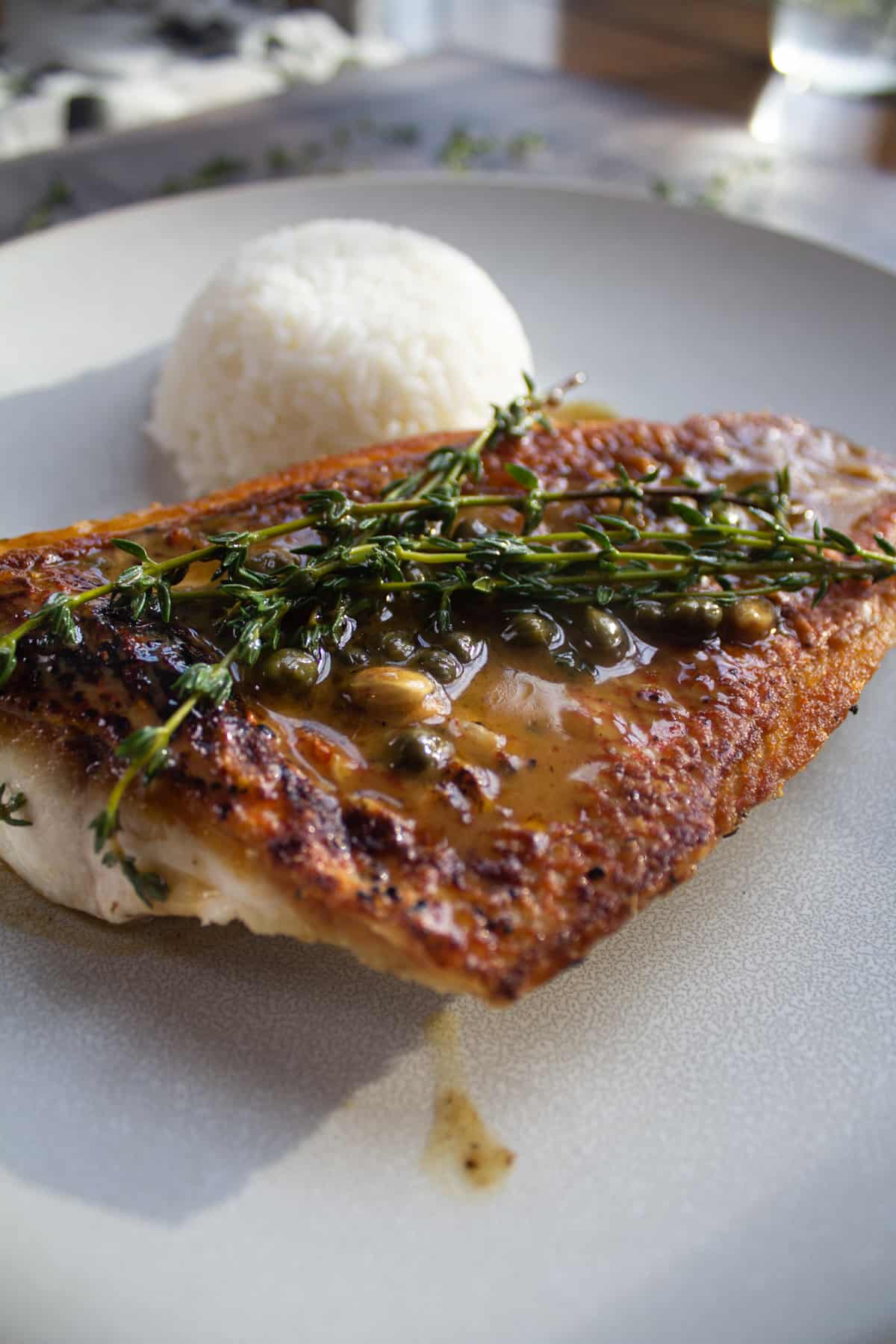
Pan-searing fish fillets is, without a doubt, my favorite method for cooking fish. The magic happens when the skin touches the hot pan, transforming into a beautifully crisp, golden layer that provides a delightful textural contrast to the tender, melt-in-your-mouth flesh. This technique is particularly well-suited for a mild, firm fish like vermillion snapper, enhancing its natural sweetness and preventing it from becoming dry. While this recipe specifically highlights vermillion snapper, feel free to apply these pan-searing principles to any snapper variety or other similar firm white fish, such as cod or sea bass.
Essential Ingredients for this Recipe
- 2 fillets of vermillion snapper or your preferred snapper variety
- Avocado oil for searing (chosen for its high smoke point)
- Seasoning: fine sea salt, freshly ground black pepper, and all-purpose flour for dredging
- Sauce ingredients: unsalted butter, briny capers, fresh lemon, aromatic thyme sprigs, minced garlic, and a splash of dry white wine
Preparing the Snapper: Seasoning and Dredging for Perfect Texture
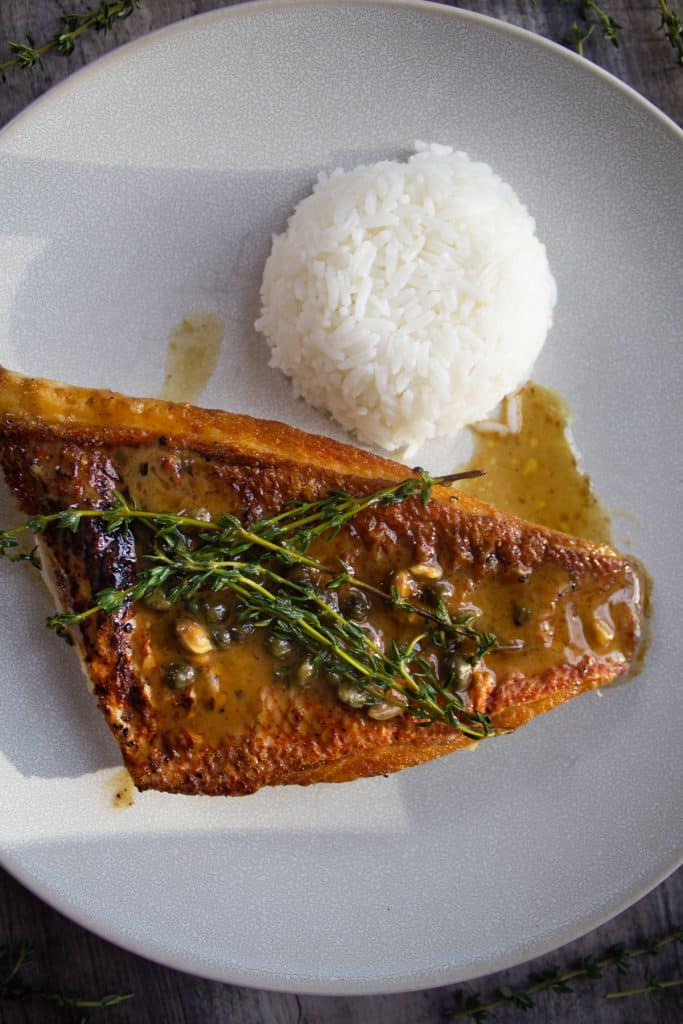
The initial step is crucial for achieving that coveted crispy skin: thoroughly pat your fish fillets dry with paper towels. Any excess moisture on the surface of the fish will cause it to steam rather than sear when it hits the hot pan, resulting in a soggy rather than crisp exterior. This simple step makes a world of difference.
Once dry, generously season both sides of each fillet with salt and pepper. Next, lightly dredge both sides of the fish in flour, ensuring an even, thin coating. The flour acts as a protective barrier, helping to seal in the fish’s natural moisture during the intense heat of pan-searing. Beyond moisture retention, this flour coating contributes significantly to the formation of that beautiful, golden-brown crispy crust. If you’re avoiding gluten, almond flour or a similar gluten-free alternative can be used effectively for the dredging process.
Perfecting the Pan-Sear for Vermillion Snapper
To begin the searing process, select a heavy-bottomed pan, such as cast iron or stainless steel, as these distribute heat most evenly. Bring the pan to a medium-high heat, then add approximately two tablespoons of avocado oil. Avocado oil is ideal due to its high smoke point, which prevents burning at high temperatures. Wait until the oil is shimmering, indicating it’s hot enough to create an instant sear.
Always start with the skin side down first when searing fish. This allows the skin ample time to crisp up beautifully. Carefully lay the snapper fillets into the hot oil and sear for about 4 minutes. You’ll know it’s time to flip when the skin is golden brown and crispy, and the fish easily releases from the pan. If the fish sticks when you try to slide a fish spatula underneath, give it another minute. The skin needs to fully crisp and form a crust before it will naturally detach.
Once flipped, sear the flesh side for another 4-5 minutes. This is where an instant-read thermometer becomes your best friend. Fish cooks incredibly fast, and even an extra minute can transform a perfectly moist fillet into a dry one. Aim for an internal temperature of exactly 145 degrees Fahrenheit (63 degrees Celsius). As soon as it reaches this temperature, remove the fish from the pan immediately.
After taking the fish off the heat, let it rest for at least 5 minutes. This resting period allows the juices to redistribute throughout the fillet, ensuring a supremely moist and flavorful result. Cutting into hot fish too soon will cause those precious juices to escape as steam, leaving you with a drier meal.
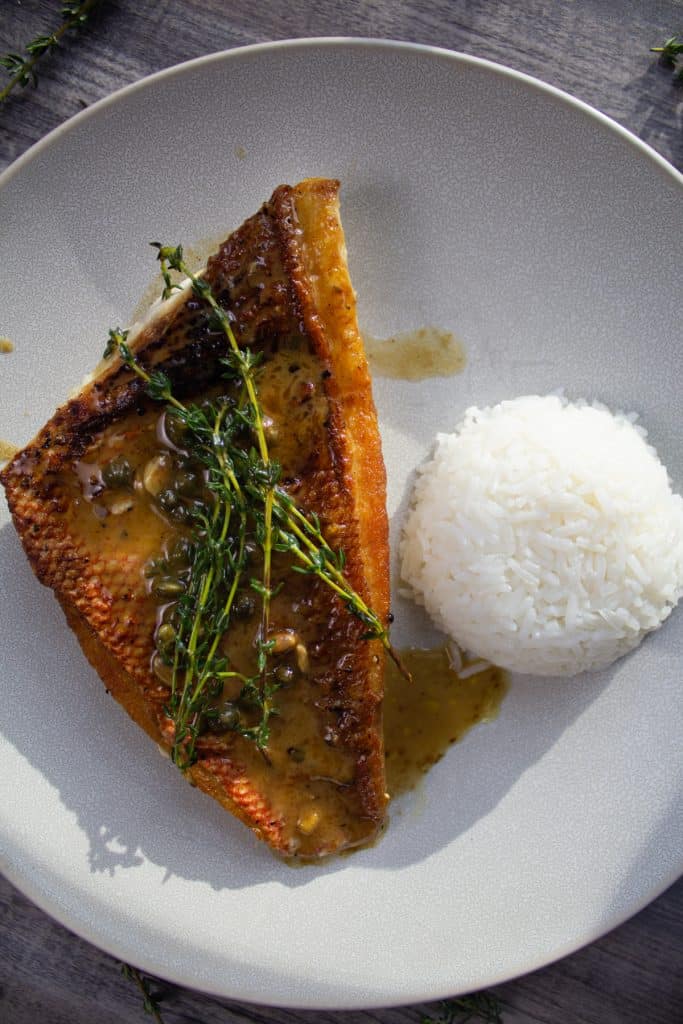
Crafting the Zesty Lemon Thyme Sauce
With the fish resting, it’s time to create the vibrant lemon-thyme sauce that will elevate your snapper to new heights. Reduce the heat of the same pan to medium-low. Add the butter and stir gently until it melts and the foam begins to subside. This initial step creates a rich, flavorful base.
Next, toss in the briny capers, finely minced garlic, and fresh thyme sprigs. Stir continuously for about 15 seconds, allowing the garlic to become wonderfully fragrant without browning. The aroma should be enticing! Squeeze in the fresh lemon juice, ensuring no seeds make their way into the pan, and then pour in the dry white wine. A crisp Sauvignon Blanc or Pinot Grigio works beautifully here, lending acidity and depth to the sauce.
Bring the mixture to a gentle simmer and reduce the liquid by half, stirring occasionally. This reduction process concentrates the flavors and helps the sauce thicken slightly. It should take approximately 2-3 minutes, and you’ll know it’s ready when a spoon dragged through the sauce leaves a path that slowly fills back in.
Finishing Touch: Drizzling the Sauce Over the Snapper
Now for the grand finale! Carefully drizzle the aromatic lemon-caper thyme sauce over each pan-seared vermillion snapper fillet. This bright, herbaceous, and slightly tangy sauce is the perfect complement to the mild, savory fish. The fresh citrus and earthy thyme cut through the richness of the butter and complement the inherent sweetness of the snapper, creating a harmonious flavor profile. The sauce will soak into the flaky fish, infusing every bite with deliciousness, while leaving a little extra in the plate—ideal for soaking up with a side of rice or crusty bread.
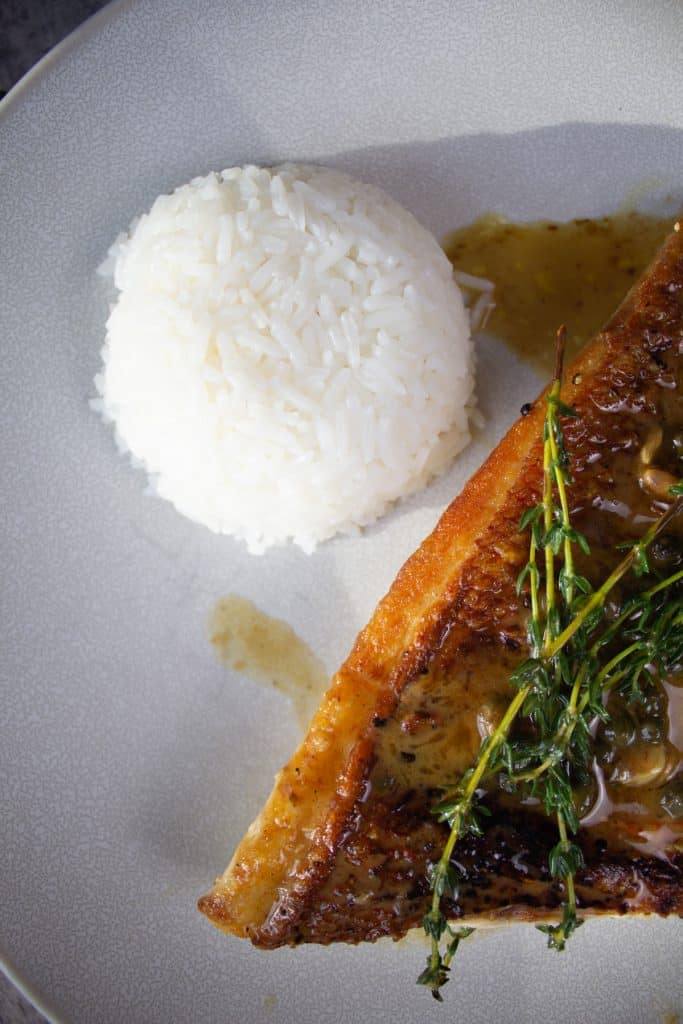
Delicious Pairings: What to Serve with Pan-Seared Vermillion Snapper
The beauty of pan-seared vermillion snapper is its versatility. It pairs wonderfully with a variety of side dishes, allowing you to create a complete and satisfying meal. My personal preference is to serve it alongside a creamy Zucchini Risotto, which beautifully absorbs the delightful juices from the snapper and the leftover lemon-caper sauce. A fresh, vibrant vegetable side is also essential to balance the meal.
Consider serving it with our flavorful Garlic Parmesan Green Beans or perfectly roasted Brussels sprouts. Other fantastic options include our decadent Maple Bacon Brussels Sprouts for a touch of sweetness and smokiness, or even a comforting bowl of Pastina Carbonara if you’re looking for a heartier pasta side. The key is to choose sides that complement the fish without overpowering its delicate flavor.
Does Snapper Have Bones? A Quick Guide to Enjoying Your Meal
Yes, vermillion snapper, like many other whole fish, typically comes with bones. While many fishmongers offer filleted and deboned options, if you’re purchasing a whole fish or fillets that still contain bones, it’s wise to be aware. I confess, I’m usually the kind of person who eats first and asks questions later, but with fish, a little caution goes a long way. Always eat carefully to avoid accidentally swallowing a small bone. If you’re buying whole fish, ask your fishmonger to debone it for you, or learn a simple technique to do it yourself at home for a smoother eating experience.
If you’ve enjoyed this delightful pan-seared vermillion snapper, we encourage you to explore more of our favorite seafood recipes to broaden your culinary horizons:
- Lemon Garlic Broiled Flounder
- Garlic Sage Seared Scallops
- Steamed Mussels in White Wine
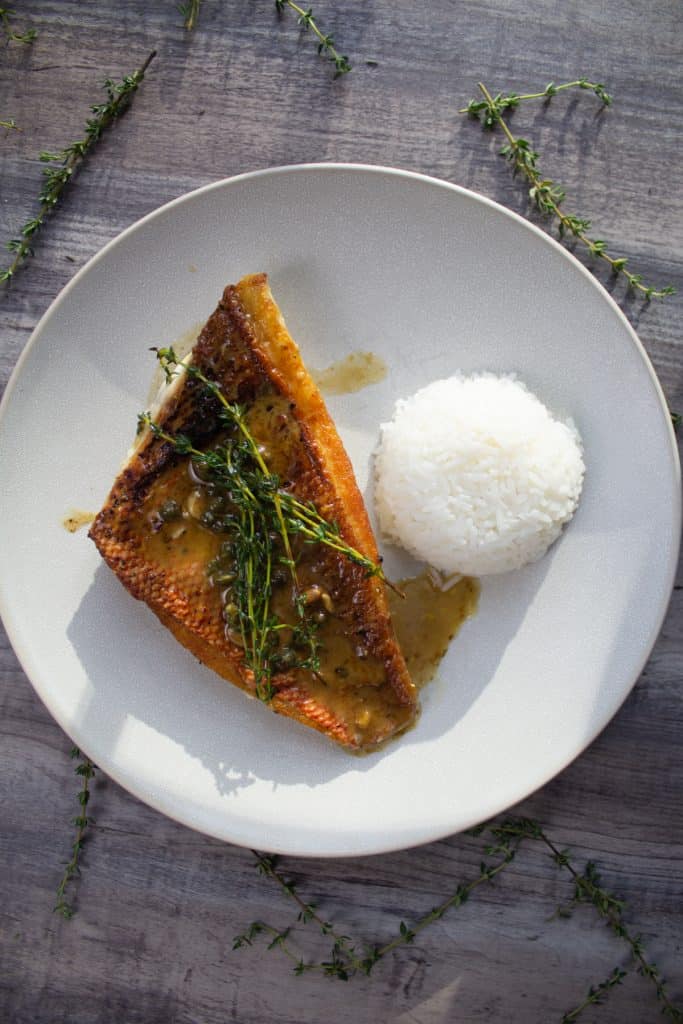
Incorporating different types of fish into your weekly meal rotation is a fantastic way to break free from culinary monotony. Chicken, while versatile, can sometimes become repetitive. By adding a fish dish and a vegetarian meal each week, you introduce exciting new flavors and nutritional variety to your diet. This pan-seared vermillion snapper recipe is an easy and delicious way to start that journey. We genuinely hope you love this recipe. If you do, please consider leaving us a review or comment below! Don’t forget to follow us on Instagram @vindelgiudice for more culinary inspiration.
📖 Recipe: Pan-Seared Vermillion Snapper with Lemon-Caper Thyme Sauce
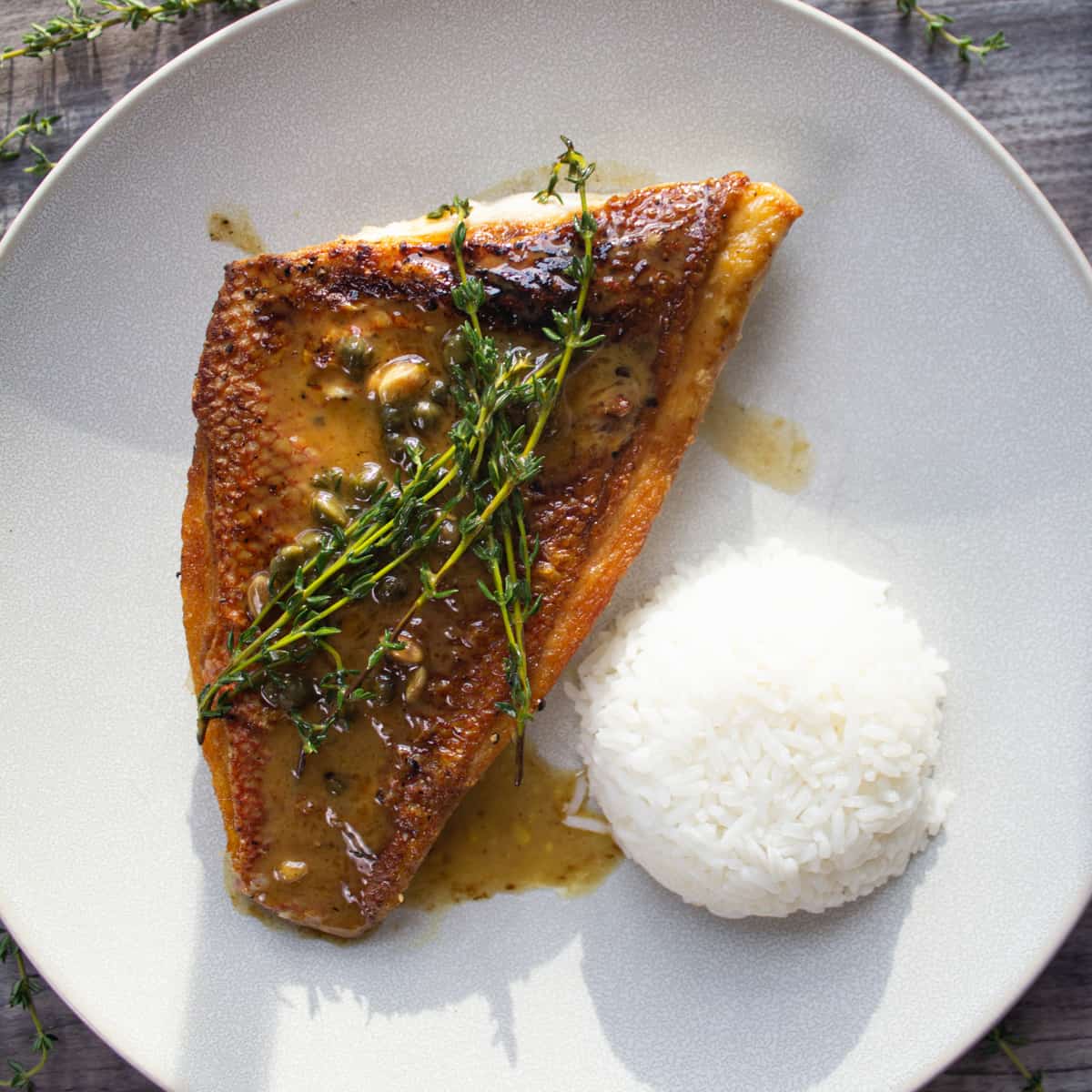
Pan-Seared Vermillion Snapper
By Vincent DelGiudice
A juicy, firm fillet seared to perfection with a bright lemon, thyme, and caper sauce.
Prep Time: 15 mins
Cook Time: 15 mins
Total Time: 30 mins
Course: Main Course
Cuisine: American
Servings: 2 people
Calories: 574 kcal
Equipment
- 1 large saucepan
Ingredients
- 2 fillets vermillion snapper or snapper of choice
- 4 tablespoons avocado oil
- 2 tablespoons butter
- 1 teaspoon salt
- 1 teaspoon pepper
- 2 tablespoons flour (all-purpose or gluten-free alternative)
- 1 tablespoon capers
- 1 lemon, juiced
- ¼ cup white wine (e.g., Sauvignon Blanc)
- 5 sprigs fresh thyme
- 1 clove garlic, crushed
Instructions
- Prepare the fish: Pat both sides of the snapper fillets thoroughly dry with paper towels. Season generously with salt and pepper, then lightly dredge both sides with flour, ensuring an even coating.
- Pan-sear the snapper: In a large, heavy-bottomed pan, add 2 tablespoons of avocado oil and heat to medium-high until shimmering. Carefully lay one fillet into the pan, skin-side down. Sear for 4-5 minutes, or until the skin is golden brown and crispy, and the fish releases easily from the pan. Using a fish spatula, carefully flip the snapper onto the opposite side and sear for another 4 minutes, or until it reaches an internal temperature of 145°F (63°C). Remove the fillet and let it rest. Repeat the same technique for the second snapper fillet.
- Make the lemon-thyme sauce: Reduce the heat of the pan to medium-low. Add the butter and stir until it melts and the foam subsides. Add the capers, crushed garlic, and fresh thyme sprigs. Stir continuously for 15 seconds until fragrant. Squeeze in the fresh lemon juice and pour in the white wine. Bring the mixture to a gentle simmer and reduce the liquid by half, stirring occasionally. The sauce should thicken slightly.
- Finish and serve: Drizzle the warm lemon-caper thyme sauce generously over each pan-seared vermillion snapper fillet. Serve immediately with your favorite sides, such as rice pilaf and seasonal vegetables.
Notes
- Seared fish cooks very quickly. It’s essential to stay vigilant, watching the fish and checking its temperature. If you’re new to cooking fish, using an instant-read thermometer is critical to ensure it hits exactly 145°F (63°C) without overcooking.
- As soon as you add the butter to the sauce, lower the heat or remove the pan from the heat entirely. Baste the fish with the flavorful butter for about 30 seconds, then immediately remove the snapper from the pan to prevent it from overcooking.
- Snapper fillets can sometimes contain small bones. I highly recommend asking your fishmonger to debone the fillets prior to cooking, or carefully remove any bones yourself before serving, to ensure a pleasant eating experience for you and your guests.
Nutrition Facts (per serving)
Calories: 574 kcal
Carbohydrates: 13g
Protein: 36g
Fat: 42g
Saturated Fat: 11g
Polyunsaturated Fat: 5g
Monounsaturated Fat: 23g
Trans Fat: 0.5g
Cholesterol: 93mg
Sodium: 2639mg
Potassium: 823mg
Fiber: 2g
Sugar: 2g
Vitamin A: 666 IU
Vitamin C: 37mg
Calcium: 102mg
Iron: 2mg
